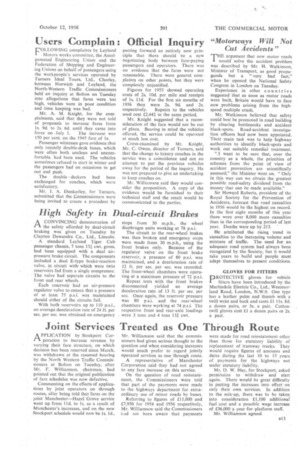High Safety in Dual-circuit Brakes
Page 47

If you've noticed an error in this article please click here to report it so we can fix it.
A CONVINCING demonstration of Inthe safety afforded by dual-circuit braking was given on Tuesday by Clayton Dewandre Co., Ltd., Lincoln.
A standard Leyland Tiger Cub passenger chassis, 7 tons 13* cwt. gross, had been equipped with a dual airpressure brake circuit. The components included a dual E-type brake-reaction valve, in circuit with. which were twin reservoirs fed from a single compressor, The valve had separate circuits to the front and rear wheels.
Each reservoir had an air-pressure regulator valve to ensure that a pressure of at least 75 p.s.i. was maintained should either of the circuits fail.
With both reservoirs up to 110 p.s.i., an average deceleration rate of 24 ft. per sec. per sec. was obtained on emergency stops from 30 m.p.h., the wheel diaphragm units working at 78 p.s.i.
The circuit to the rear-wheel brakes was then broken and emergency stops were made from 30 m.p.h.., using the front brakes only. Because of the regulator valve on the front brake reservoir, a pressure of 80 p.s.i. was maintained, and a deceleration rate of 12 ft. per sec. per sec. was recorded. The front-wheel chambers were operating at a maximum pressure of 72 p.s.i.
Repeat tests with the front brakes disconnected yielded an average deceleration rate of 13 ft. per sec. per sec. Once again, the reservoir pressure was 80 p.s.i. and the rear-wheel chambers were working at 74 p.s.i. The respective front and rear-axle loadings were 3 tons and 4 tons 1 cwt.




















































































































